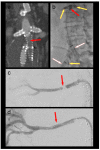A Novel Percutaneous Technique for Aorto-Iliac Thrombectomy without the Risk of Embolization
- PMID: 37508805
- PMCID: PMC10376630
- DOI: 10.3390/bioengineering10070778
A Novel Percutaneous Technique for Aorto-Iliac Thrombectomy without the Risk of Embolization
Abstract
Classic surgical thrombectomy of the aorta and iliac arteries through an incision in the groin vessels harbors the risk of embolization to the viscero-renal as well as hypogastric arteries, while percutaneous endovascular thrombectomy techniques can lead to peripheral embolization to the lower limbs. Therefore, we describe a novel, percutaneous technique that tackles the above issues. Furthermore, we also present our initial experience using the technique. The principle of the technique is to percutaneously place large-bore sheaths in the iliac arteries that deliberately occlude the latter to protect the lower limbs from embolization. Through one of these sheaths, over wire Fogarty® catheters can be placed and inflated in the ostia of the coeliac trunk, superior mesenteric artery, renal arteries, and hypogastric arteries as needed. A large thrombectomy balloon catheter is then used to bring any aorto-iliac thrombus into the sheaths, whereafter the thrombus is removed from the sheaths by simply deflating their valves. Additional endovascular procedures of the aorto-iliac branches can be performed as needed. We report nine procedures in 8 patients (4 males and 4 females) with a median age of 63 (53-68.5). Additional endovascular procedures were performed in 6 (66.7%) procedures. All but one procedure were technically successful, and all patients had palpable foot pulses on completion of the procedures, while no patient had clinical signs of peripheral embolization. This technique is a very valid addition to the vascular surgeon's armamentarium when treating aorto-iliac thrombotic events because it is minimally invasive while still protecting against embolization and offering the flexibility to perform a wide range of additional endovascular procedures where needed.
Keywords: endovascular; percutaneous thrombectomy; protection from embolization.
Conflict of interest statement
The authors declare no conflict of interest.
Figures



References
LinkOut - more resources
Full Text Sources

